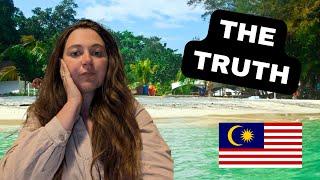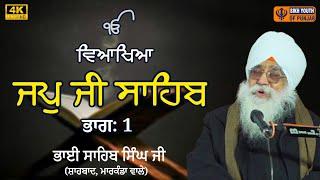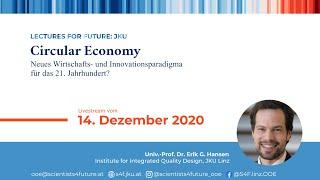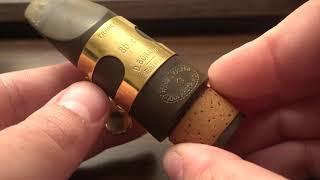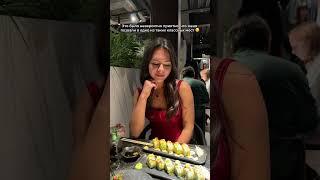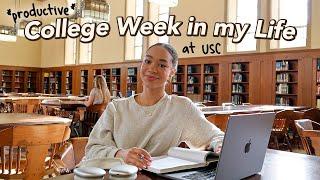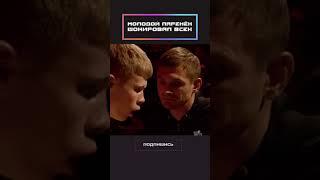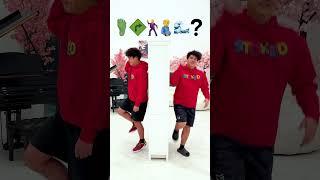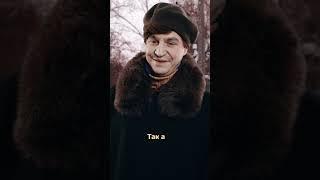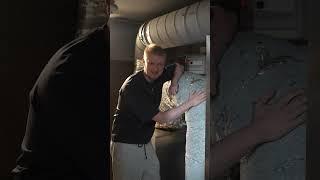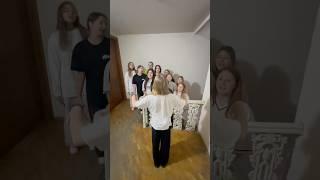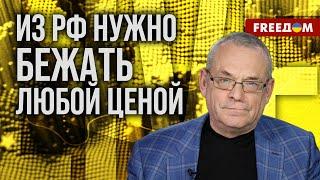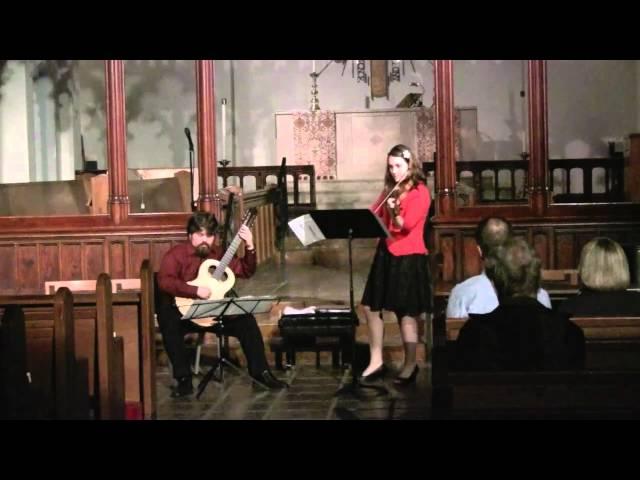
Tempo del Fuoco performs - Thomas Schuttenhelm: "when the surface would suffice"
Tempo del Fuoco (Sarah Larsen, violin and Nick Cutroneo, classical guitar) perform a newly composed work by Connecticut based composer, Thomas Schuttenhelm, entitled: "when the surface would suffice": the song in Jasper's music box (an interrupted tango). This recording was from a live performance on November 20th, 2010.
For more information on Thomas Schuttenhelm, please visit his website at: http://www.thomasschuttenhelm.com
This piece was commissioned by Tempo del Fuoco and dedicated to us. The following are the composer's notes about the piece:
"when the surface would suffice": the song in Jasper's music box
(an interrupted tango)
To Nick Cutroneo and Sarah Larsen
"when the surface would suffice" explores the intersection of decidedly contemporary conventions with the more traditional rhythms of a tango which continually interrupt it. The title is derived from the textures found in Jasper John's painting "Tango" (1955). It is not uncommon to find objects on or even exceeding the boundaries of his canvas's. Indeed, in the lower right hand corner of "Tango" there is a small key protruding—the key to a music box. In an interview Johns remarked: "I wanted to suggest a physical relationship to the pictures that was active. In Tango, to wind the key and hear the sound, you had to stand relatively close to the painting, too close to see the outside shape of the picture." The motion of the viewer, coming in close to inspect the objects on the canvas, and then moving out to see it in its entirety created a tango between person observing the canvas and the artwork itself. A similar effect is achieved in the present tango when the mechanized pulse (the music box perhaps?) of one section is interrupted an impulse, represented here by the more recognizable rhythm of the traditional tango. Each time these occur it coincides with a rubato requiring the instrumentalists to make certain accommodations for the sake of the ensemble, and in so doing, they become more aware of each other.
The piece begins with a brief introduction where the guitar functions as both a percussionist and an accompanist (providing both the cranks and clicks of a music box, and a simple harmonic background for the violinist, who ironically 'plucks' out its first notes), while attempting to establish a pulse from the relative stillness of the opening measures. The pulse is eventually established, but only through the accumulation of beats (in the guitar) and of volume (in both). The next section, arguably the most melodic section of the entire piece, establishes a tighter dialogue between the two instrumentalists. Following this are alternating sections where the pulse becomes interrupted by the impulse, each time becoming more and more exaggerated and more and more excited.
The circumstances surrounding the true origin of the tango are unknown. Ultimately I think it better to acknowledge the plurality of its manifestations, which transcend any specific time, place, or person, rather then to assign or claim ownership, as the present tango draws from a multiplicity of sources. Regardless of origin, any attempt to historicize it requires delving into folklore. But perhaps folklore, and by extension myth, is the appropriate place for these notions to reside as it allows, some might say demands, a re-telling—a continual re-creation, and in the process it is brought always into the present and part of a living tradition. If we accept this, then we must ultimately reject the false myth of authenticity. It is agreed that tangos originated in the past, and we are probably in a 'late' stage of its development. The present tango celebrates in its own 'lateness' as enthusiastically as it does its mythological origins.
For more information on Thomas Schuttenhelm, please visit his website at: http://www.thomasschuttenhelm.com
This piece was commissioned by Tempo del Fuoco and dedicated to us. The following are the composer's notes about the piece:
"when the surface would suffice": the song in Jasper's music box
(an interrupted tango)
To Nick Cutroneo and Sarah Larsen
"when the surface would suffice" explores the intersection of decidedly contemporary conventions with the more traditional rhythms of a tango which continually interrupt it. The title is derived from the textures found in Jasper John's painting "Tango" (1955). It is not uncommon to find objects on or even exceeding the boundaries of his canvas's. Indeed, in the lower right hand corner of "Tango" there is a small key protruding—the key to a music box. In an interview Johns remarked: "I wanted to suggest a physical relationship to the pictures that was active. In Tango, to wind the key and hear the sound, you had to stand relatively close to the painting, too close to see the outside shape of the picture." The motion of the viewer, coming in close to inspect the objects on the canvas, and then moving out to see it in its entirety created a tango between person observing the canvas and the artwork itself. A similar effect is achieved in the present tango when the mechanized pulse (the music box perhaps?) of one section is interrupted an impulse, represented here by the more recognizable rhythm of the traditional tango. Each time these occur it coincides with a rubato requiring the instrumentalists to make certain accommodations for the sake of the ensemble, and in so doing, they become more aware of each other.
The piece begins with a brief introduction where the guitar functions as both a percussionist and an accompanist (providing both the cranks and clicks of a music box, and a simple harmonic background for the violinist, who ironically 'plucks' out its first notes), while attempting to establish a pulse from the relative stillness of the opening measures. The pulse is eventually established, but only through the accumulation of beats (in the guitar) and of volume (in both). The next section, arguably the most melodic section of the entire piece, establishes a tighter dialogue between the two instrumentalists. Following this are alternating sections where the pulse becomes interrupted by the impulse, each time becoming more and more exaggerated and more and more excited.
The circumstances surrounding the true origin of the tango are unknown. Ultimately I think it better to acknowledge the plurality of its manifestations, which transcend any specific time, place, or person, rather then to assign or claim ownership, as the present tango draws from a multiplicity of sources. Regardless of origin, any attempt to historicize it requires delving into folklore. But perhaps folklore, and by extension myth, is the appropriate place for these notions to reside as it allows, some might say demands, a re-telling—a continual re-creation, and in the process it is brought always into the present and part of a living tradition. If we accept this, then we must ultimately reject the false myth of authenticity. It is agreed that tangos originated in the past, and we are probably in a 'late' stage of its development. The present tango celebrates in its own 'lateness' as enthusiastically as it does its mythological origins.
Тэги:
#Tango #Thomas_Schuttenhelm #Violin_and_Guitar_Duo #Duo #Violin #Guitar #Classical_Guitar #Tempo_del_Fuoco #Chamber_Music #Long_Beach #CaliforniaКомментарии:
WORLD TRIP Begins | Sweden 1
J House Vlogs
8 HUGE lies about Borneo nobody talks about
Claire's Footsteps
Время вместе️ #любовь
Эвелина Колодникова
Japji Sahib Katha || By Gyani Sahib Singh Ji Markanda Wale
Sikh Youth Of Punjab
FORD TOURNEO CUSTOM 320 2 0 ECOBLUE 170CV AUT AWD PL TITANIUM
BiAuto Levico Terme
"Circular Economy | Kreislaufwirtschaft" von Erik Hansen | Lectures4Future JKU
Scientists For Future AT
The right way to put on a ligature???
Dale Fedele
آموزش بافت اسکاج | اسکاج بافتنی | قلاب بافی فوقالعاده آسان برای مبتدیان| آموزش بافت زیر لیوانی
آموزش بافتنی Amozesh baftanii
Моё первое сотрудничество #блогер
Эвелина Колодникова


